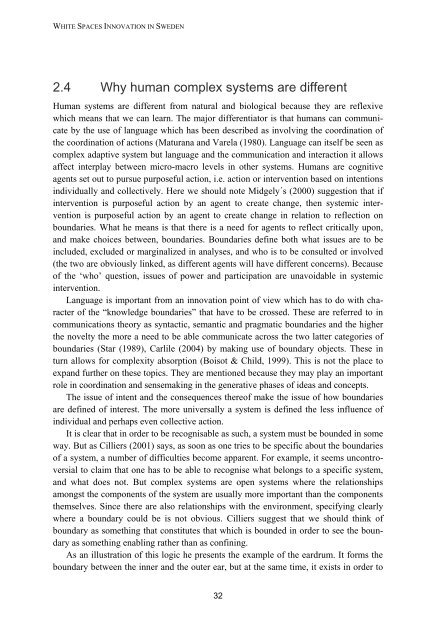White Spaces Innovation in Sweden - Innovation policy for ... - Vinnova
White Spaces Innovation in Sweden - Innovation policy for ... - Vinnova
White Spaces Innovation in Sweden - Innovation policy for ... - Vinnova
Create successful ePaper yourself
Turn your PDF publications into a flip-book with our unique Google optimized e-Paper software.
WHITE SPACES INNOVATION IN SWEDEN2.4 Why human complex systems are differentHuman systems are different from natural and biological because they are reflexivewhich means that we can learn. The major differentiator is that humans can communicateby the use of language which has been described as <strong>in</strong>volv<strong>in</strong>g the coord<strong>in</strong>ation ofthe coord<strong>in</strong>ation of actions (Maturana and Varela (1980). Language can itself be seen ascomplex adaptive system but language and the communication and <strong>in</strong>teraction it allowsaffect <strong>in</strong>terplay between micro-macro levels <strong>in</strong> other systems. Humans are cognitiveagents set out to pursue purposeful action, i.e. action or <strong>in</strong>tervention based on <strong>in</strong>tentions<strong>in</strong>dividually and collectively. Here we should note Midgely´s (2000) suggestion that if<strong>in</strong>tervention is purposeful action by an agent to create change, then systemic <strong>in</strong>terventionis purposeful action by an agent to create change <strong>in</strong> relation to reflection onboundaries. What he means is that there is a need <strong>for</strong> agents to reflect critically upon,and make choices between, boundaries. Boundaries def<strong>in</strong>e both what issues are to be<strong>in</strong>cluded, excluded or marg<strong>in</strong>alized <strong>in</strong> analyses, and who is to be consulted or <strong>in</strong>volved(the two are obviously l<strong>in</strong>ked, as different agents will have different concerns). Becauseof the „who‟ question, issues of power and participation are unavoidable <strong>in</strong> systemic<strong>in</strong>tervention.Language is important from an <strong>in</strong>novation po<strong>in</strong>t of view which has to do with characterof the “knowledge boundaries” that have to be crossed. These are referred to <strong>in</strong>communications theory as syntactic, semantic and pragmatic boundaries and the higherthe novelty the more a need to be able communicate across the two latter categories ofboundaries (Star (1989), Carlile (2004) by mak<strong>in</strong>g use of boundary objects. These <strong>in</strong>turn allows <strong>for</strong> complexity absorption (Boisot & Child, 1999). This is not the place toexpand further on these topics. They are mentioned because they may play an importantrole <strong>in</strong> coord<strong>in</strong>ation and sensemak<strong>in</strong>g <strong>in</strong> the generative phases of ideas and concepts.The issue of <strong>in</strong>tent and the consequences thereof make the issue of how boundariesare def<strong>in</strong>ed of <strong>in</strong>terest. The more universally a system is def<strong>in</strong>ed the less <strong>in</strong>fluence of<strong>in</strong>dividual and perhaps even collective action.It is clear that <strong>in</strong> order to be recognisable as such, a system must be bounded <strong>in</strong> someway. But as Cilliers (2001) says, as soon as one tries to be specific about the boundariesof a system, a number of difficulties become apparent. For example, it seems uncontroversialto claim that one has to be able to recognise what belongs to a specific system,and what does not. But complex systems are open systems where the relationshipsamongst the components of the system are usually more important than the componentsthemselves. S<strong>in</strong>ce there are also relationships with the environment, specify<strong>in</strong>g clearlywhere a boundary could be is not obvious. Cilliers suggest that we should th<strong>in</strong>k ofboundary as someth<strong>in</strong>g that constitutes that which is bounded <strong>in</strong> order to see the boundaryas someth<strong>in</strong>g enabl<strong>in</strong>g rather than as conf<strong>in</strong><strong>in</strong>g.As an illustration of this logic he presents the example of the eardrum. It <strong>for</strong>ms theboundary between the <strong>in</strong>ner and the outer ear, but at the same time, it exists <strong>in</strong> order to32
















